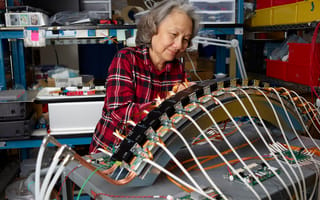In the 4th and 5th centuries BCE, celebrity doctor and ancient founder of medicine Hippocrates said cancer was an excess of so-called black bile, one of four bodily humors he believed made up the human body. Later, in the 17th century, Dutch doctors who found multiple cases of breast cancer in the same household decided that the disease must be contagious.
Needless to say, cancer diagnosis and treatment have come a long way.
While a cure remains elusive, advances in radiation therapy, molecular biology, immunotherapy and other fields have armed modern oncologists with the most powerful treatment tools in history. And advancements in software have helped streamline processes and treatments in the healthcare industry at large.
But healthcare professionals and technologies have found uses for digital technology beyond the standard electronic health record software now found in hospitals across the industrialized world. From complex machine learning algorithms to relatively simple scheduling tools, technologists and researchers are working through new ways to help diagnose, treat and support cancer patients during their care.

Detection
While the jury is still out on the success of early detection in patients with certain types of cancer, like breast cancer, there are other variants where detection does seem to make a demonstrable difference. One of these is colorectal cancer, whose studies indicate that early identification leads to a 90 percent five-year survival rate. South San Francisco company Freenome is building a test that can detect the cancer from a simple blood draw instead of traditional methods like biopsies or stool samples.
Freenome treats cell-free DNA taken from blood samples with methylation and protein biomarkers. Using signals produced by those additives, Freenome’s machine learning algorithms work to recognize biomarker patterns that give scientists information about a cancer’s stage, type and even treatment options. This analysis is prohibitively complex for a human observer, but Freenome has trained its algorithms on thousands of blood samples to help it recognize cases that other tests might miss.

Treatment
While machine learning can help form a more precise diagnosis, modern machinery and tracking techniques are creating more targeted, less-invasive methods of treatment. Take radiation therapy, which is traditionally used as the primary care method for patients with early-stage cancer when cancerous cells are localized to a distinct tumor within an organ.
Over time, advances in radiation therapy technology have allowed clinicians to deliver large doses of radiation to precise points within the body, maximizing the effect on cancer cells while minimizing damage to healthy cells nearby. One of the latest advances comes from Hayward-based RefleXion Medical, which is pairing this form of radiation therapy — known as stereostatic radiosurgery — with an imagery technique called positron emission tomography, or PET, to detect and treat cancer in patients in a single session, even if they have multiple tumors.
RefleXion’s treatment method works by injecting PET tracers into a patient, and then placing the patient inside the company’s X1 machine. Using signals from the PET tracers, the machine detects biological “emissions” from a tumor, showing its shape, size and location within a patient in real time.
That real-time element is important, because traditional radiation therapy doesn’t account for natural body movement during treatment. Despite being told to hold still, patients undergoing radiation therapy cannot completely immobilize themselves — normal breathing and blood circulation cause the body to move in small ways, which can cause radiation therapy to irradiate non-cancerous cells.
Using the PET tracing method, RefleXion says it can track a tumor as it moves with the body and apply radiation therapy with more precision.

Support
Cancer patients spend a lot of time in hospitals and doctor’s office waiting rooms. The disease and associated treatment programs cause a wide variety of symptoms and side effects, and telemedicine platforms like San Francisco-based One Medical help people assess the severity of a medical ailment and whether or not they need an in-person visit. Having cancer is stressful enough without having to find, book and attend appointments every time a patient has a minor rash or wants a quick word of medical advice.
One Medical attempts to simplify the lives of patients with cancer and other chronic illnesses by offering 24-hour virtual care, appointment booking functionality, digital health records and proactive health-related reminders built into a single app. The goal here is to restrict in-person visits — a tax on the valuable time and resources of caregivers and patients alike — to moments when a patient’s physical presence is absolutely required.
Telehealth services have been an important resource for cancer patients — especially in rural areas — and they are becoming increasingly so in the era of COVID-19 and social distancing. So while One Medical increases the number of available touchpoints with a primary caregiver, it can simultaneously protect immunocompromised patients from exposure to infectious diseases like COVID-19 by reducing the time they physically spend in medical facilities.






